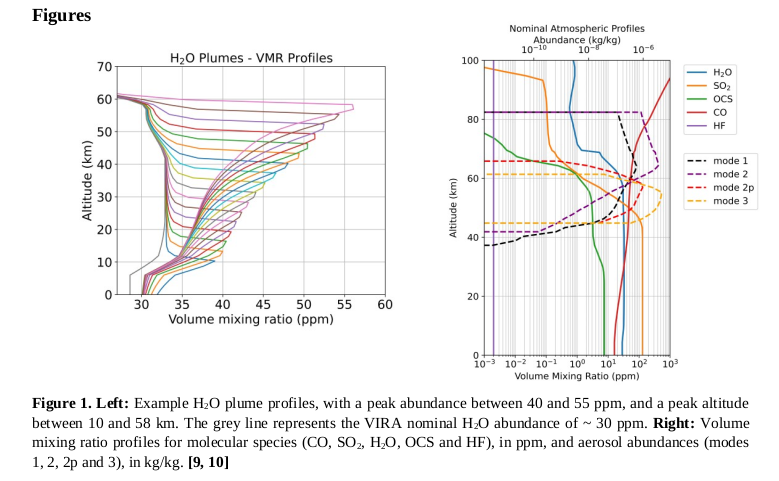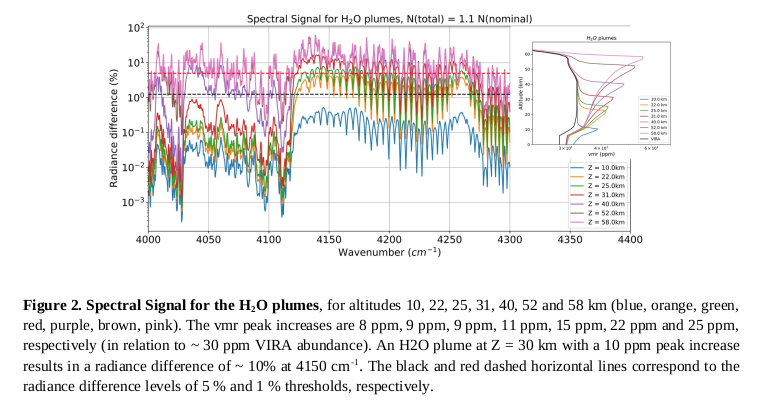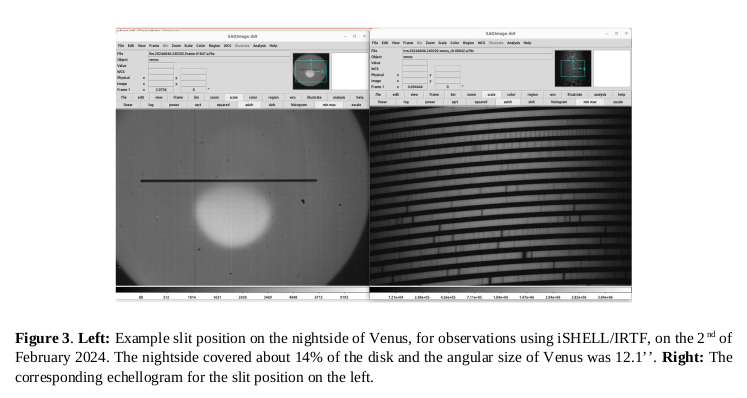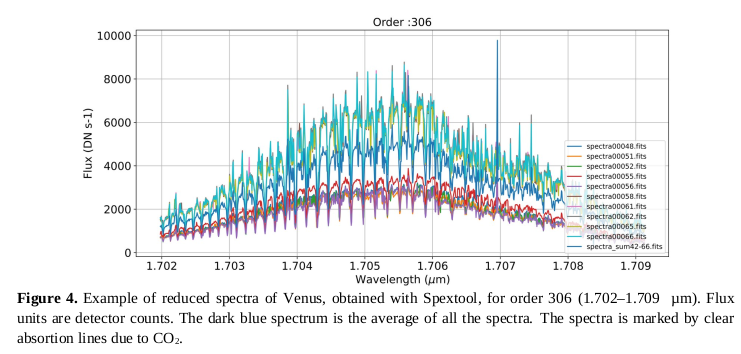Volcanic gas plumes’ effects on the spectrum of Venus
- 1Faculty of Sciences, University of Lisbon, Portugal
- 2Instituto de Astrofísica e Ciências do Espaço (IA), Lisbon, Portugal
- 3Royal Belgian Institute for Space Aeronomy (BIRA-IASB), Brussels, Belgium
- 4Instituto Dom Luiz, Faculty of Sciences, University of Lisbon, Portugal
Simulations of spectra during a volcanic event
The composition and the variability of the lower atmosphere of Venus are critical to understanding the surface-atmosphere interactions, the atmospheric evolution and the volatile exchanges between the interior and the atmosphere [1, 2, 3]. The lower atmosphere can be investigated on the near-infrared spectral windows on the nightside, centered at 1.18 µm (0-15 km), 1.74 µm (20-30 km) and 2.3 µm (30-45 km) [4, 5], which provides a chance to detect volcanic species such as H2O, SO2. CO, HCl and HF, which are common species on Earth volcanoes [3].
The Planetary Spectrum Generator (PSG) [6, 7, 8] was used to simulate the nightside 2.3 µm spectrum of Venus, in nadir-geometry, using a VIRA atmospheric template for temperature and molecular vertical abundance profiles and four aerosol modes, of effective radii of 0.49 µm, 1.18 µm, 1.56 µm and 4.25 µm [9, 10]. The spectral resolution was defined as R = 7500.
An H2O volcanic gas plume was modeled using a Johnson unbounded distribution, with a maximum value of volume mixing ratio (vmr) at a chosen altitude and a slow decrease towards lower altitudes. The profile was defined as a perturbation of the VIRA nominal H2O profile (~ 30 ppm). with a peak vmr in the range 10-70 ppm and a peak altitude in the range 10-58 km. For each plume, the total integrated column density was conserved, defined as a scaler of the VIRA value, N(total)(H2O) ~ 13.23 kg m-2.
An H2O plume at Z = 30 km with a 10 ppm peak increase results in a radiance difference of ~ 10% at 4150 cm-1. Ground-based observations and future space missions, such as iSHELL/IRTF and EnVision’s VenSpec-H spectrograph [11], respectively, should have the high-spectral resolution and sensitivity required to detect such H2O variations due to a possible volcanic eruption event.
Spectral Retrievals of iSHELL/IRTF spectra
On this framework, we are currently investigating the sensitivity of iSHELL/IRTF to retrieve the abundance of H2O and its temporal and latitudinal variability using the near-infrared spectral window at 1.74 µm (20-30 km) and 2.3 µm (30-45 km) [4]. The retrieval is ongoing with the ASIMUT tool (Vandaele+2006) [12].
We performed 6 hours of observations, in February 2nd-3rd 2024, of Venus dayside and nightside using the K3 (2.26-2.55 µm) and H3 filters (1.64-1.82 µm) on the iSHELL/IRTF instrument. The slit width used was 0.375’’ x 5’’ (R ~ 75 000) and it was positioned parallel to the axis of rotation. iSHELL is a cross-dispersed high-spectral resolution 1.1-5.3 µm echelle spectrograph (R ~ 80 000), located in Maunakea, Hawaii [13]. Wavelength calibration, flat fielding, dark correction and sky subtraction were performed using the Spextool data reduction software [14, 15].
The dayside straylight contribution on the nightside, in order 306, was removed by scaling of the dayside spectra with a scaler computed as the nightside/dayside ratio, in order 295 (1.764-1.771 µm), where we modeled expected counts ~ 0.
We identified several CO2 absorption lines in order 306 (1.702–1.709 µm) and 305 (1.708-1.714 µm) and some hints of H2O and HCl absorption lines in order 300 (1.735-1.742 µm). The absolute flux calibration and retrieval of the H2O and HCl column densities are currently ongoing, using ASIMUT [12].
References. (1) Gilmore et al. 2023, Space Sci Rev. (2) Gillmann et al. 2022, Space Sci Rev (3) Wilson et al. 2024, Space Sci Rev (4) Bézard et al. 2009, JGR Planets (5) Tsang et al. 2009, Journal of Quantitative Spectroscopy and Radiative Transfer (6) Villanueva et al. 2018, Journal of Quantitative Spectroscopy and Radiative Transfer; (7) Smith et al. 2013, JGR Planets (8) Dias et al. 2022, Atmosphere (9) Zasova et al. 2006, Cosmic Research; (10) Haus et al. 2010, Icarus (11) Robert et al. 2021, EPSC. (12) Vandaele et al. 2006, Proc of the First 'Atmospheric Science Conference' (13) Rayner et al. 2022, PASP 134 (14) Cushing et al. 2004, PASP 116 (15) Vacca et al. 2003, PASP 115.
Funding. This work was supported by FCT through the research grants UIDB/04434/2020 and UIDP/04434/2020 and a fellowship grant 2022.09859.BD. Funded by ESA in the framework of MWWM - Mars Wind and Wave Mapping project. SR acknowledges funding by BELSPO with financial and contractual support coordinated by the ESA Prodex Office (PEA 4000137943, 4000128137).
Acknowledgements. We kindly thank Maxence Lefévre, from the University of Oxford, for the discussions on volcanic gas plumes, and Shohei Aoki, from the University of Tokyo, for the collaboration concerning the data reduction.




How to cite: Dias, J., Machado, P., Robert, S., Erwin, J., C. Duarte, J., and Quirino, D.: Volcanic gas plumes’ effects on the spectrum of Venus, Europlanet Science Congress 2024, Berlin, Germany, 8–13 Sep 2024, EPSC2024-519, https://doi.org/10.5194/epsc2024-519, 2024.